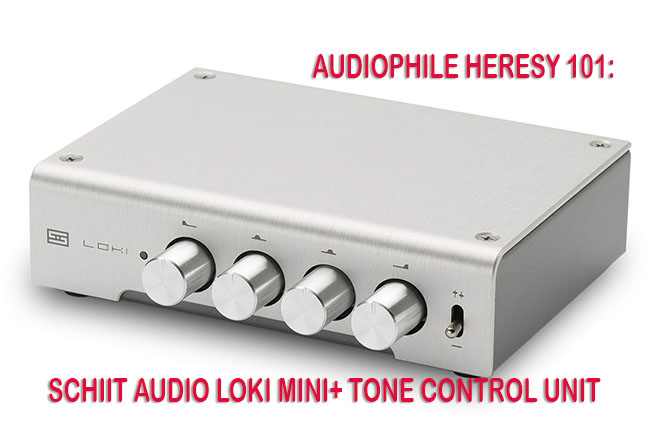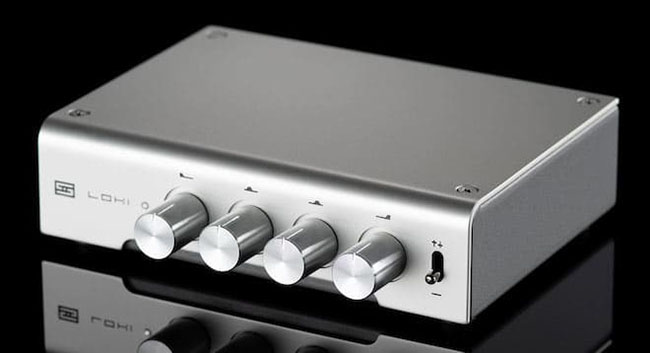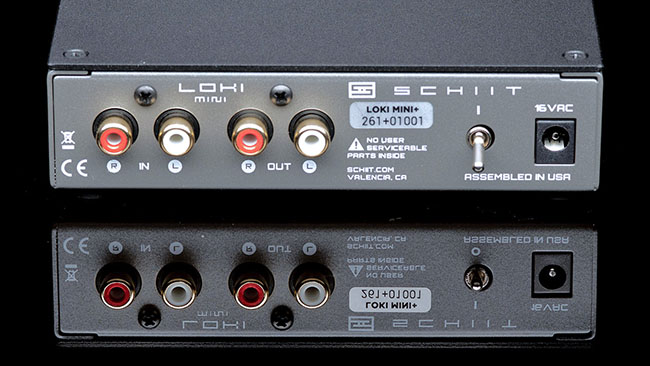The Schiit Audio Loki Mini+ Tone Control Unit by Paul Szabady

Ever since the mid-1970s, the presence of tone controls on a home audio component has been a tell-tale sign that the component had no aspirations to ultimate fidelity. Given the ever-evolving pursuit of perfect linearity and neutrality in no-compromise audio designs of the time, adding user ability to deliberately alter the unit’s frequency response seemed like pure self-defeating folly.
The elimination of tone controls quickly became rigid design dogma. Even components aimed at the mass market, which deliberately used questionable ‘features’ as their primary selling point in lieu of perfectionist sound quality and musical communication, eventually added ‘defeat’ switches to eliminate their tone controls, equalizers, and other hyped features.
As the development of the “audiophile” and “High End,” world-views and markets emerged during that decade, the elimination of tone-altering capabilities was never questioned. This is true today, almost 50 years later. Contemporary audio perfectionists are more likely to be shocked by a product that does nothing but alter the frequency response of the audio signal. Audiophile Heresy 101.


 Enter Schiit Audio’s Loki Mini+ tone control unit. Schiit Audio has developed a reputation for maverick thinking and a penchant for unorthodox but high-performance products, all sold at very affordable prices. Indeed, they are pocket-change cheap compared to the excesses of the High End. Selling for $149, the Loki Mini+ certainly follows Schiit’s tradition. It offers four bands of tonal adjustment through 4 rotating potentiometers centered at 20 Hz, 400 Hz, 2 kHz, and 8 kHz. A front-panel by-pass switch allows instantaneous return to unaltered response.
Enter Schiit Audio’s Loki Mini+ tone control unit. Schiit Audio has developed a reputation for maverick thinking and a penchant for unorthodox but high-performance products, all sold at very affordable prices. Indeed, they are pocket-change cheap compared to the excesses of the High End. Selling for $149, the Loki Mini+ certainly follows Schiit’s tradition. It offers four bands of tonal adjustment through 4 rotating potentiometers centered at 20 Hz, 400 Hz, 2 kHz, and 8 kHz. A front-panel by-pass switch allows instantaneous return to unaltered response.
The Loki can be inserted in-line of a source component, into a tape monitor loop, or between a preamplifier and power amp. Diminutive in size and weight, the Loki+ consumes little shelf space and utilizes Schiit’s standard cosmetics, a detachable wall-wart power supply, and the power switch on the unit’s back. A choice of black or silver finishes is available. The signal is handled in the analog mode throughout. There is no conversion of the signal into digital.
Historically, the pursuit of ultimate-fidelity component design has always had an ascetic, hair-shirt aspect to it. Purism in design seemed to evoke a Puritan outlook. As designers (and listeners) realized that everything in an audio component’s circuit affected sound quality, there was a worldwide movement in design to eliminate the non-essential features of a given component. Logically, the first to go was the tone control circuit, as it often introduced distortion of various noxious kinds (including all-important phase and transient distortions) in addition to adding noise.
Part of Schiit’s rationale for producing the Loki tone control unit was to deal with the biggest variation in system performance: the quality of the recording itself. The recording industry, outside of Classical, and Jazz recordings perhaps, makes no pretense that it is wed to any ideal of true fidelity. The ideal of an “absolute sound” is as alien to it as serving art and beauty. We are all passively at the mercy of the miking, equalization, and mixing decisions made in the recording studio by recording engineers and producers, the latter now considering themselves to be “artistes.” The Loki Mini + allows you to do something about it.
Similarly, imperfections of transducer technology (be they in the phono cartridge, loudspeaker or headphone,) in source components and of room acoustics are now open to effective and inexpensive alteration and improvement.
While tone controls and equalizers have been probably the most abused items in horrible-sounding audio systems – crap source components feeding crap amplifiers driving crap speakers altered by crap equalizer/tone control circuits – applying very high-quality equalization to a very high-resolution audio chain is a completely different experience. It can lead to surprising improvements in both artistic communication and sound quality.
Schiit wisely circumvented the prevailing prejudice against tone controls and equalizers by designing the Loki+ to “ultra-fi” technical specification in terms of signal-to-noise ratio, frequency bandwidth, and harmonic and intermodulation distortion levels. Setting the tone controls to their indented 12 o’clock positions (“flat”) and hitting the Loki +’s defeat toggle switch revealed no audible difference between by-pass and active mode. This transparency is a giant step forward and is exceptionally welcome, especially compared to the tone controls and equalization schemes of the past.
 Readers familiar with my past reviews might know that I run three different systems in three different rooms for critical evaluations. I first inserted the Loki Mini+ into my “rational, real-world” system. The electronics now include the Schiit Freya+ tube preamp driving Schiit’s Aegir Class A power amp – unsurpassed affordable references for musical communication, low artistic distortion, and ultra-fidelity. Since the Freya+ does not include a tape monitor loop, I connected the Loki+ directly between the Freya’s output and the Aegir’s input.
Readers familiar with my past reviews might know that I run three different systems in three different rooms for critical evaluations. I first inserted the Loki Mini+ into my “rational, real-world” system. The electronics now include the Schiit Freya+ tube preamp driving Schiit’s Aegir Class A power amp – unsurpassed affordable references for musical communication, low artistic distortion, and ultra-fidelity. Since the Freya+ does not include a tape monitor loop, I connected the Loki+ directly between the Freya’s output and the Aegir’s input.
I used Monitor Audio’s now ‘out-of-print’ Bronze 5 loudspeakers as my test dummies, though they are now superseded by the current Bronze 5G. Now, no circa $1,000/pair loudspeaker is going to be “perfect,” but the Bronze 5’s, when mounted on Stillpoints (TM) isolators, reveal a level of neutrality, resolution, and bandwidth (flat response in my room to 32Hz) that belies their affordable price.
Room acoustics and furnishings of this listening room tended to dull the extreme top end of these speakers in-room on some recordings, which affected percussion and lyric intelligibility slightly. A boost on the Loki’s 2kHz and 8kHz controls effectively eliminated this slight peccadillo. I know – heresy.
My first concern with any review item is its effect on musical communication – you know – timing, rhythm, emotion, expression, and thrust. I’m pleased to report that the Loki+ made no negative effect here. In fact, it actually improved musical thrust on Rock (and all of its sub-genres and permutations.) I found myself not using the Loki+ much with Classical music recordings. With Jazz, I sometimes boosted the 8kHz range when I wanted to spotlight percussion or cut the 2kHz range to tone down over-the-top recordings of trumpets. The point is – you can alter any recording to your taste and to your ears.
The sad recent death of Rolling Stones’ drummer Charlie Watts prompted some long listening sessions of the Stones’ recordings. Even though Mick Jagger and particularly Keith Richards have long given credit to Watts as being the essential force that drove the band musically, most Rolling Stones recordings never spotlit Watts’ contributions. A little adjustment of the Loki allowed heightened perception of Watts’ playing, leading to increased appreciation of Watts’ drumming skills.
Completely neglected by the audio industry is the variability of the individual listener’s hearing ability. This is by far the largest elephant in the room facing the audio world. Let’s be frank. The high-performance audio world is almost exclusively male, and the High End’s stratospheric pricing means most males entering it are in their prime earning period of their lives, which in the US means age 40 and older. Males, on average, have poorer hearing than females (particularly in the high-frequency range,) are more likely, traditionally, to be exposed to hearing-damaging pursuits, and at age 40+, are in the prime period of presbycusis-induced hearing loss. This age-related hearing loss affects mostly the high frequencies and extends downward to around 2 kHz – the midrange presence range. It continues to worsen with age.
The Schiit Loki + offers a simple and dirt-cheap remedy for those affected by presbycusis: simply rotate the 2 kHz and 8 kHz controls until the music sounds right. It certainly beats changing components, speakers, or cables in an attempt to compensate for the loss of high-frequency perception!
 I next inserted the Loki + into my main testing system, which is based on the Sound Lab Dynastat loudspeakers, speakers I’ve used as a reference for over 25 years. Located in a large listening space, this system is flat from 22 Hz to the ultra-sonic region. Again, I could hear no compromise in transparency when I inserted the Loki + into the system. In fact, the effect of interconnect used in connecting the Loki was far greater than any contribution the Loki made in by-pass mode. It was heartening to experience the Loki +’s transparency in a high-resolution system. Finally, I inserted the Loki into a preamp’s tape monitor loop, allowing a complete by-pass of the unit. Again, no audible degradation.
I next inserted the Loki + into my main testing system, which is based on the Sound Lab Dynastat loudspeakers, speakers I’ve used as a reference for over 25 years. Located in a large listening space, this system is flat from 22 Hz to the ultra-sonic region. Again, I could hear no compromise in transparency when I inserted the Loki + into the system. In fact, the effect of interconnect used in connecting the Loki was far greater than any contribution the Loki made in by-pass mode. It was heartening to experience the Loki +’s transparency in a high-resolution system. Finally, I inserted the Loki into a preamp’s tape monitor loop, allowing a complete by-pass of the unit. Again, no audible degradation.
I find the Schiit Loki + Mini tone control unit to be a very useful and valuable tool for dealing with the vagaries of Rock/Pop recordings, both analog and digital. At $149, it is chump-change cheap from the perspective of the “High End,” but can offer an improvement in musical satisfaction and sound quality far out of any proportion to its humble price. For those who feel ‘guilty’ about its low price, one can opt for Schiit’s Lokius.
Priced at $299, the Lokius offers balanced in/out in addition to single-ended IC connection and expands frequency band selection to 6: 20Hz, 120 Hz, 400 Hz, 2 kHz, 6 kHz, and 16 kHz. The Schiit Audio Loki Mini+ encourages audiophile heresy without fear of being burned at the stake.
Highly recommended.
![]()
paul szabady
Specifications:
Price: $149 US
Frequency Response: 20Hz-20Khz, -0.1db, 2Hz-800KHz, -3dB
Maximum Output: 10V RMS into 10K Ohms
THD: Less than 0.0008%, 20Hz-20KHz, at 2V RMS in/out, pots centered, active stage enabled, less than 0.005% at any potentiometer setting
IMD: Less than 0.001%, CCIF
SNR: Greater than 114db, unweighted, referenced to 2V RMS
Crosstalk: -80dB, 20Hz-20KHz
Output Impedance: 75 ohms
Input Impedance: 47K ohms
Bands: 20Hz, 400Hz, 2kHz, 8kHz
Adjustment: +/-12dB at 20Hz and 8kHz, +/-6dB at 400Hz and 2kHz
Topology: fully discrete, all-bipolar, symmetrical current-feedback design with matched parts throughout, driver stage, DC coupled, and DC servo
Filtering: capacitor-gyrator for 20Hz, capacitor-inductor (LC) for all other bands
Power Supply: “Wall wart” style 14-16VAC transformer, regulated +/- 15V rails
Power Consumption: 4W
Size: 5 x 3.5 x 1.25”
Weight: 1 lb
Website: www.schiit.com/products/loki-mini-3
Stereo Times Masthead
Publisher/Founder
Clement Perry
Editor
Dave Thomas
Senior Editors
Frank Alles, Mike Girardi, Russell Lichter, Terry London, Moreno Mitchell, Paul Szabady, Bill Wells, Mike Wright, and Stephen Yan,
Current Contributors
David Abramson, Tim Barrall, Dave Allison, Ron Cook, Lewis Dardick, John Hoffman, Dan Secula, Don Shaulis, Greg Simmons, Eric Teh, Greg Voth, Richard Willie, Ed Van Winkle, Rob Dockery, Richard Doron, and Daveed Turek
Site Management Clement Perry
Ad Designer: Martin Perry






Be the first to comment on: The Schiit Audio Loki Mini+ Tone Control Unit by Paul Szabady